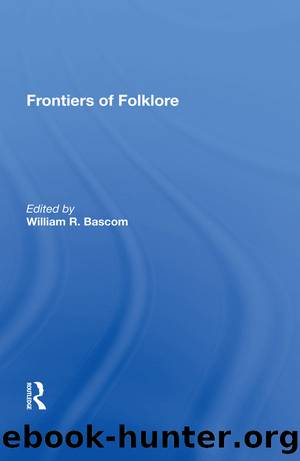Frontiers Of Folkloreh by William R Bascom

Author:William R Bascom [Bascom, William R]
Language: eng
Format: epub
ISBN: 9780367170769
Barnesnoble:
Publisher: Taylor & Francis
Published: 2020-10-19T00:00:00+00:00
built.
Later, in the same year, on October 10, 1975, this artist began a new epic, detailing the activities of a Xhosa woman named Nomasomi; this performance took twenty-one days to complete, and totalled between 130 and 140 hours. The two epics are quite different in many ways, but the artist sees the second building thematically and culturally on the first, focusing on Xhosa traditional doctors and medicine (Mrs. Zenani is herself a traditional Xhosa doctor of some renown), as she moves her Xhosa history away from magical, supernatural activities characteristic of the Mityi narrative. Like the earlier work, the second depends on imaginative narratives and a complex of emotionally experienced forms to communicate its message. Then, on November 17, 1975, she commenced a third epic, wholly unified and in many ways independent of the others, yet one which she viewed as a development of the earlier works, the third part of an epic trilogy that rivals the Mahabarata in length.
This work has Nobantu as the chief character, a fictional Xhosa leader noted for her humane treatment of her subjects, a development, the artist asserted, of the earlier works. This astonishing performance, which the artist sees as an imaginary history of Xhosa civilization, took place from July 1 to November 26 of 1975, a total of some three hundred hours. The performer had last experienced the narratives as a unified work some fifty or sixty years before, when her grandmother performed them for her and her peers. She recalled that the performances occurred when she was a young teenager, and took place in the evenings and late afternoons, over long periods of time. The narratives as she was developing them in 1975 were not, of course, precisely like those her grandmother had created--âWeâre living in different timesâ, she said. But the images and the movements of characters were substantially the same. And the formal relationships were little altered. This is the real tradition she emphasized, not those âlittle childrenâs talesâ that her neighbors told. She had herself more recently performed many of the separate narratives that comprise the vast epics, but only as individual twenty or thirty minute stories.
In the epic as in the much shorter performances, the experience is of forms, and combinations of forms. The body in those narratives in which movement is engaged in by the artist and her audience, assists in revealing the forms and their inter-relationships. The significance of the nonverbal aspects of such narratives was emphasized for me in August, 1972, when, attending performances among the Xesibe people of the Transkei in South Africa, I experienced another
Figure 2 Nongenile Masithathu Zenani during a performance.
Download
This site does not store any files on its server. We only index and link to content provided by other sites. Please contact the content providers to delete copyright contents if any and email us, we'll remove relevant links or contents immediately.
Cecilia; Or, Memoirs of an Heiress — Volume 1 by Fanny Burney(32064)
Cecilia; Or, Memoirs of an Heiress — Volume 3 by Fanny Burney(31458)
Cecilia; Or, Memoirs of an Heiress — Volume 2 by Fanny Burney(31409)
The Great Music City by Andrea Baker(30784)
We're Going to Need More Wine by Gabrielle Union(18635)
All the Missing Girls by Megan Miranda(14748)
Pimp by Iceberg Slim(13781)
Bombshells: Glamour Girls of a Lifetime by Sullivan Steve(13687)
Fifty Shades Freed by E L James(12918)
Talking to Strangers by Malcolm Gladwell(12879)
Norse Mythology by Gaiman Neil(12836)
For the Love of Europe by Rick Steves(11524)
Crazy Rich Asians by Kevin Kwan(8891)
Mindhunter: Inside the FBI's Elite Serial Crime Unit by John E. Douglas & Mark Olshaker(8707)
The Lost Art of Listening by Michael P. Nichols(7164)
Enlightenment Now: The Case for Reason, Science, Humanism, and Progress by Steven Pinker(6877)
The Four Agreements by Don Miguel Ruiz(6321)
Bad Blood by John Carreyrou(6280)
Weapons of Math Destruction by Cathy O'Neil(5835)
